Export trends
This amount was almost equivalent to total exports for 2006. A high growth rate in exports (37 per cent in value and 35 per cent in volume) has been maintained this year.
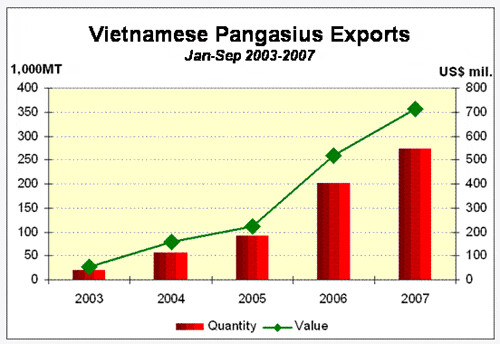
Stricter regulations on hygiene and food safety set by the authorities in Russia - the second largest importer of Vietnamese pangasius - have been the ‘price’ which the Vietnamese seafood industry has paid for the rapid growth of trade to this market. One result has been the reduction of pangasius exports to Russia. By the end of September this year, exports fell by one per cent in volume and two per cent in value.
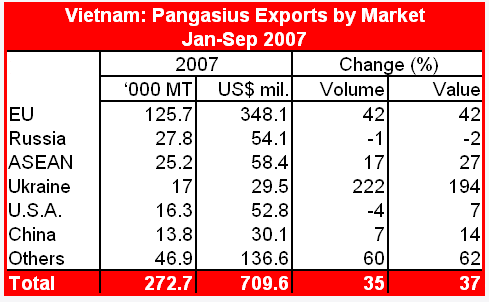
Vietnamese pangasius exporters seemed to rapidly deal with fluctuations in the Russian market. Statistics show a reorientation of exports with sales to the Ukraine increasing by 222 per cent in volume and 194 per cent in value. The disparity between growth rates of volume and value suggests a drop in average export prices for the Ukraine which contrasts with the trend for other key destinations.
EU wants frozen freshwater fish fillets
The EU market remained the largest destination for Vietnamese pangasius. In the first nine months of 2007, exports to the EU amounted to 125,700 MT, valued at US$348.1 million, an increase of 42 per cent in both volume and value, with more than 70 per cent (volume and value) going to four key markets: Spain, Poland, the Netherlands and Germany. These countries were also the top four importing markets in the EU for frozen fillets of freshwater fish. Vietnam has remained the largest supplier of this category to EU markets.
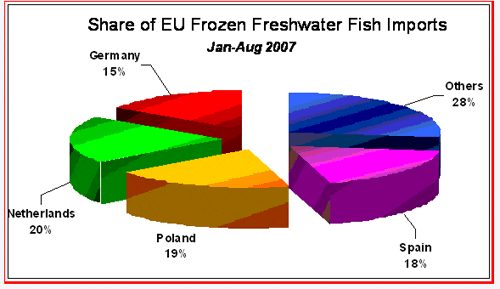
Among EU markets for imported frozen freshwater fish fillets, the Netherlands ranked first with 20 percent. In fact, the four key markets referred to above represent more than 70 per cent of total EU imports. It should be noted that, according to Vietnamese statistics, the average unit price of Vietnamese pangasius products increased in most EU markets this year while EU statistics show different results.
Two reasons contributed to this disparity. One was that Vietnamese exports reflect a switch to higher dollar priced frozen fillets. Secondly, the strong appreciation of the euro against the US dollar over the past year has meant a negative effect on average unit values expressed in euros, as reported in EU statistics.
The Netherlands
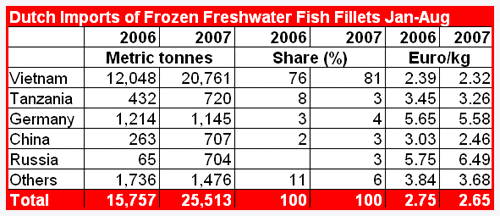
Vietnam accounts for the largest share in Dutch imports of frozen freshwater fish fillets. Vietnam’s volume share increased from 75 per cent over the January-August period 2006 to 81 per cent for the same period this year following growth of 72 per cent. However, the average unit price fell from €2.39 per kilo to €2.32 per kilo. Most suppliers from third countries outside EU followed this downward trend, especially China with a sharp reduction from €3.03 per kilo to €2.46 per kilo.
Spain
Vietnam and Tanzania continue to be the largest suppliers to the Spanish market for frozen freshwater fish fillets. Vietnam maintained its dominant share which increased from 83 per cent during the January-August period last year to 87 per cent for the same period this year.
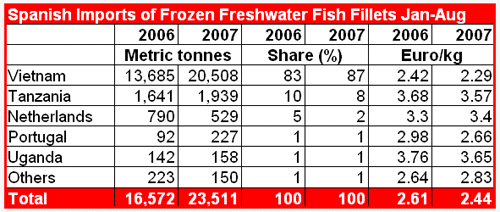
Unit value figures suggest that Vietnam has significant price advantages in the Spanish market in particular and in the EU in general. The average unit value for Spanish imports of Vietnamese product in 2006 was €2.42 per kilo and down to €2.29 per kilo in 2007, well below the €3.68 per kilo in 2006 and €3.57 per kilo in 2007 for Tanzanian products.
Poland - prime opportunity
Among EU markets, Poland is the main destination for Vietnamese pangasius. After this country joined the EU, seafood trade between it and Vietnam, especially in frozen freshwater fish fillets, has seen a strong growth.
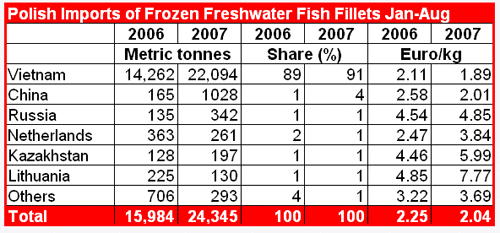
With 22,000 MT of frozen freshwater fish fillets imported into Poland during the January-August period this year, Vietnam confirmed its position as the largest supplier in this product category. China was in second position with just 1,650 MT but with a very strong growth rate of up to 523 per cent in volume terms.
In contrast to products supplied by either EU member countries, such as Germany and the Netherlands, or African countries, the average unit value for Chinese products was not much higher than that of Vietnamese products (€2.01 per kilo compared with €1.89 per kilo respectively). In fact, a rapid decline in Chinese unit values is evident between 2006 and 2007 took place, from €2.58 per kilo down to €2.01 per kilo.
Outlook
Strongly increased supplies from Vietnam and China have put pressures on other suppliers of frozen freshwater fish fillets to EU markets. The average unit price for this category of product has decreased from €2.93 per kilo to €2.80 per kilo and the downward trend is expected to continue.
Advantages regarding natural conditions and labour costs basically help Vietnamese pangasius to be more competitive in terms of price in most export markets. However, due to similarities in natural conditions and products, it is expected that China will provide more competitive pressure for Vietnam’s seafood exporters in the future.
With continued depreciation of the US dollar against the euro, the increasing purchasing power of European currencies makes the EU one of the most attractive markets with further potential for Vietnamese freshwater fish products.
December 2007

